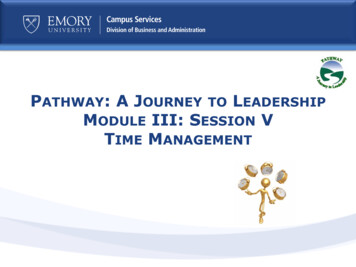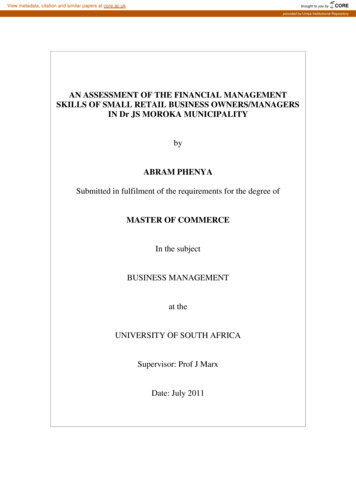
Transcription
Time Management for a Small BusinessParticipant GuideTable of ContentsWelcome . 3What Do You Know? Time Management for a Small Business . 4Pre-Test . 5Time Management . 6Discussion Point #1: Benefits of Time Management . 7Time Management Plan. 7SMART Goals . 10Discussion Point #2: SMART Goals . 11Discussion Point #3: Tasks Developed with SMART Goals . 11Prioritizing Tasks . 11Managing Your Time . 14Working Your Plan. 16Discussion Point #4: Task Delegation. 16Reviewing and Updating Your Time Management Plan. 17Common Distractions, Obstacles, and Solutions . 18Four Key Points to Remember . 19For Further Information . 20Post-Test. 21Evaluation Form . 22DISCLAIMERThese training materials are intended as general guidance only and may or may not apply to a particular situationbased on the circumstances. The materials do not create any legal rights or impose any legally binding requirementsor obligations on the Federal Deposit Insurance Corporation (FDIC) and U.S. Small Business Administration (SBA).The FDIC and SBA make no claims or guarantees regarding the accuracy or timeliness of this information andmaterial.The content of this training material is not designed or intended to provide authoritative financial, accounting,investment, legal or other professional advice which may be reasonably relied on by its readers. If expert assistancein any of these areas is required, the services of a qualified professional should be sought.Reference to any specific commercial product, process, or service by trade name, trademark, manufacture, orotherwise does not constitute an endorsement, a recommendation, or a preference by the FDIC and SBA or theUnited States government.Money Smart for a Small Business CurriculumPage 2 of 22
Time Management for a Small BusinessParticipant GuideWelcomeWelcome to the Time Management for a Small Business training. By taking this training, you are taking an important steptoward building a better business. This guide accompanies the Time Management for a Small Business PowerPointPresentation.ObjectivesAfter completing this training, you will be able to: Explain the concept of time management and why is it important to a small business.Explain the time management practices which are commonly employed by a small business, including:o Pareto analysiso ABC methodo Eisenhower methodo POSEC methodMoney Smart for a Small Business CurriculumPage 3 of 22
Time Management for a Small BusinessParticipant GuideWhat Do You Know?Time Management for a Small BusinessInstructor: Date:This form will allow you and your instructors to see what you know about time management, both before and after thetraining. Read each statement below. Please circle the number that shows how much you agree with each statement. ABC method Eisenhower methodPOSEC methodMoney Smart for a Small Business CurriculumAgreeStrongly AgreeStrongly DisagreeDisagreeAgreeStrongly Agree2. I can explain the time management practiceswhich are commonly employed by a smallbusiness, including: Pareto analysisDisagree1. I can explain the concept of time managementand why is it important to a small business.After TrainingStrongly DisagreeBefore Training1234123412341234Page 4 of 22
Time Management for a Small BusinessParticipant GuidePre-TestTest your knowledge of time management before you go through the training.1. Which of the following characterizes time management? Select all that apply.a. Prioritizing tasksb. Organizing fundsc. Managing distractionsd. Setting goals2. Which of the following are not components of a time management plan? Select all that apply.a. A daily guideb. A list of tasks by priorityc. A list of unattainable goalsd. Descriptions of how goals will be achieved3. Within what timeframe should mid-term goals be accomplished?a. Two monthsb. Twelve monthsc. Two to five yearsd. Four months4. Which of the following are time management practices commonly used by small businesses? Select the fourthat apply.a. POSEC methodb. Pareto analysisc. Eisenhower methodd. Priority methode. ABC method5. How often should you review your time management plan? Select all that apply.a. Dailyb. Weeklyc. Monthlyd. Yearlye. NeverMoney Smart for a Small Business CurriculumPage 5 of 22
Time Management for a Small BusinessParticipant GuideTime ManagementTime management is best defined as a systematic prioritization of tasks and competing demands to complete the mostimportant tasks within a target timeframe. The goal of time management is to reduce the distractions which lower thenumber of tasks a business owner completes.Importance of Time ManagementIs the saying, “Time is money,” true? If your business runs out of money, you always have the opportunity to get more.More money is “simply a sale away.” On the other hand, once time is past you can never get that time back nor can youadd more hours to a day. Yes, poor time management can cost you and your business tremendous amounts of money.Realize, however, that the better you manage your time the more money you can earn. With time management, businessowners maximize how much they get done each working day. Having a written time management plan serves as a guidefor working smarter instead of harder.Benefits of Time ManagementWith effective time management, you will: Maximize what can be accomplished in a work dayMaximize the use of the limited resources Identify critical areas for special attentionIdentify tasks that can be delegated to employees Track progress toward your goalsThe number one benefit of time management is more business, which means more income. Time management will allowyou to be more focused on key tasks, be more organized, have less stress, and have more time for family, friends, andother interests. Here are some questions to help you determine if you might benefit with better time management: In what ways have you wasted or not optimally managed your time? How many times have you looked up and wondered where all the time went?How many times has your day ended where you didn’t complete a key task and/or desires? How many times have you missed dinner or other activities with family and friends to work late to finishsomething that was not done?Money Smart for a Small Business CurriculumPage 6 of 22
Time Management for a Small BusinessParticipant GuideDiscussion Point #1: Benefits of Time ManagementThe purpose of this discussion is to help you realize ways to save time. Using the following list of benefits, describe howyou would personally benefit from better time managementBenefits of time management: More business, which means more income! More focused on key tasks More organizedLess stressMore time with family, friends, and other interestsDescribe how you might benefit from better time management.Time Management PlanThe first step to better time management is a time management plan. A good time management plan must be in writing,containing a list of prioritized tasks, on a daily, weekly, and monthly basis, for achieving your goals. Then, use the timemanagement plan to help you prioritize your work. A time management plan will keep you focused and on target tocomplete the most important needs in the day.Sample Time Management PlanTake time to study the following example of a time management plan.Money Smart for a Small Business CurriculumPage 7 of 22
Time Management for a Small BusinessParticipant GuideMy Time Management Plan (Sample)GOALI will generate a minimum of 6,000 in sales every month, starting the month after next (March).Steps1.2.3.4.Create a list of potential clients.Make 12 sales per month worth 500 each.Confirm proper inventory levels.Continuously develop sales skills.TasksA. Create and maintain a list of 1,500 companies regionally (ongoing process) that would benefit from using myproduct.a. Use free databases available online and at the local library.b. Use an annual publication which lists the top businesses in the region.c. Determine which types of businesses to which I would like to market and review the state’s license databaseto locate these businesses.d. Contact friends and family members to see if they know of any potential customers.e. Research online lists and lead sources.f. Join the local chamber for access to their membership list.B. Make 12 sales per month worth 500 each ( 6,000).a. Finalize pitches.i. Sales presentationii. 30-second “elevator pitch”b. Finalize sales literature, including business cards.c. Make 50 calls per day, with the goal of speaking with 20 people.d. Return all messages by the close of the following business day.e. Attend 4 networking events per month to generate new contacts.f. Track and analyze progress to see if the specific subtasks above are working to meet the 6,000 per monthsales goal or if they need to be modified.C. Confirm and maintain proper inventory levels in support of this sales goal.D. Continuously develop sales skills.a. Read one sales book from the library every month.b. Attend one sales training each year.c. Subscribe to one personal development magazine and/or newsletter.E. Bank deposit every Thursday.F. Pay bills no later than the 15th of each month and reconcile bank statements.G. Check SBA website by the 5th of each month for new topics and trainings of interest.H. Check email and voicemail twice each day, at noon and 3 p.m., and again at 4:30 p.m. on Fridays.I.Update and maintain time management plans.a. Update the next day’s plan with any carryover items from the previous day.b. Every Friday afternoon create the five-day time management plan for the up-coming week.Money Smart for a Small Business CurriculumPage 8 of 22
Time Management for a Small BusinessParticipant GuideKey Elements to a Time Management PlanAn effective time management plan has five important elements:1. Clearly defined written goals2. Detailed list of tasks3. Prioritization of the tasks4. List of important ongoing business functions5. Built in flexibilityKey Element 1: Clearly Defined Written GoalsStart your time management plan with clearly defined goals. What do you want to do? What do you want to be? What doyou want to have? Your time management plan will be derived from these stated goals. When writing your goals, identifyeach of them as a short-term (quarterly), mid-term (12 months), or long-term (two to five years) goal.Key Element 2: Detailed List of TasksBreakdown each goal into a set of clearly defined tasks that need to be completed to accomplish the goal. Goals do not getaccomplished on their own. Breaking down goals into written tasks allows you to see and understand what actions arerequired. The task list will also help you to see what resources are needed and how to allocate them. You may see areaswhere resources are lacking. Use the task list to start identifying ways to get the tasks done in a timely manner.Key Element 3: Prioritization of the TasksWith any task or “to-do” list, some items on the list will be more important than others. Always try to complete the mostimportant tasks first because these tasks will usually have the greatest impact on your goals and, by extension, yourbottom line. However, some less important tasks may become critically urgent. For example, if you have an ongoing taskto pay all your bills on the 15th of each month and you forget to pay the electric bill, the unpaid bill will become a highpriority to avoid an interruption in service.Key Element 4: List of Important Ongoing Business FunctionsMany times, important ongoing business functions are not directly related to a goal and are not listed as steps or tasks.However, these functions absolutely must be completed to continue business operations. A complete list of keycomponents of your business operations may not be attached to a goal but needs to be included in your time managementplan. To start, here are examples of tasks that you might need to perform on a daily, weekly, or monthly basis.Money Smart for a Small Business CurriculumPage 9 of 22
Time Management for a Small BusinessParticipant GuideDaily Tasks Check and reply to email Return phone calls Read and reply to mailWeekly Tasks Manage and maintain an inventory Deposit funds File all documentsMonthly Tasks Pay bills Attend a networking functionKey Element 5: Built in FlexibilityEach day has only 24 hours. Your time is limited. By assigning a time estimate to complete each prioritized task, you canplan your day such that the most important tasks are always completed in a timely manner. When scheduling, avoid fillingevery hour of the day with tasks. Leave plenty of unscheduled time for flexibility.SMART GoalsProper goal setting starts with knowing what you want to accomplish. Try to write your goals using the following format: Specific—state the goal precisely. Measurable—good measures allow you know when a goal is completed.Attainable—resources needed to complete the goal are within your reach. Relevant—the goal is applicable to your business.Time Bound—the goal has a completion date or timeframe for being achieved.Examples of SMART Goals: I will move my business from my home into office space in less than four months from today. I will design two new training programs for clients take starting in January.I will hire a web designer and have our new website operational by the end of next month. This month I will research the benefits of leasing a copier versus buying a copier in time for when the currentlease is up in 52 days.Examples of goals that do not follow the SMART format: I will get some new clients.I will increase my sales this year. I’m going to write a marketing plan.I’m going to pay off my credit cards and get out of debt.Identify, test, and fine-tune your written goals using the SMART format.Money Smart for a Small Business CurriculumPage 10 of 22
Time Management for a Small BusinessParticipant GuideDiscussion Point #2: SMART GoalsThe purpose of this discussion is to help you to create a SMART goal for your business.Write one of your business goals using the SMART format.Using SMART GoalsMany business owners take the time to write their goals but struggle to achieve them. The next action to take with yourSMART goals is to write down the steps and tasks to complete them, identifying the “who, what, when, where, and why”for completing the goal.Discussion Point #3: Tasks Developed withSMART GoalsThe purpose of this discussion is to help you think about the tasks that should be listed under your SMART goals.Look at the SMART goal you wrote for your business. Write the steps and tasksneeded to achieve your goal.Prioritizing TasksSmall business owners are usually juggling many priorities and responsibilities. The key element to making your timemanagement plan work most efficiently is to prioritize your tasks. Your tasks will range in importance from beingextremely critical to success, to something that would be nice to have done, to an action that would not matter much evenif the action never got done.Money Smart for a Small Business CurriculumPage 11 of 22
Time Management for a Small BusinessParticipant GuideRead about the following four processes for prioritizing tasks: Pareto analysis ABC method Eisenhower methodPrioritize by Organizing, Streamlining, Economizing, and Contributing (POSEC) methodPareto AnalysisThe Pareto principle, upon which Pareto analysis is based, is often referred to as the “80/20 rule,” which states that 20percent of a person’s effort will produce 80 percent of the result. For example, if your goal is 100,000 in sales, 20percent of your effort toward this goal will result in 80,000 in sales. The remaining 80 percent of what you do will onlyresult in the remaining 20,000. Use Pareto analysis to prioritize your time on tasks that produce the best overall result.Small business owners need to understand the Pareto principle because they are usually juggling many priorities.ABC MethodAnother common method for prioritizing tasks is the ABC method, which ranks each task with the letter A, B, or C. Themost important tasks on your time management plan are given the letter A, less important tasks the letter B, and the leastimportant tasks the letter C. Once each task is assigned a letter, the subtasks for each task (A, B, and C) are furtherprioritized by number (1, 2, and 3). A task identified as A-1 is completed before task A-2, which is completed before taskB-1, and so on through all the tasks. The ABC method can be combined with Pareto analysis.Money Smart for a Small Business CurriculumPage 12 of 22
Time Management for a Small BusinessParticipant GuidePrioritizing tasks with the ABC method is not the same as the process you go through to make your time managementplan. Do not confuse the ABC method of prioritizing with the process of breaking goals into steps and tasks.Eisenhower MethodThe Eisenhower method is named after President Dwight D. Eisenhower, who said, “What is important is seldom urgentand what is urgent is seldom important.”To use the Eisenhower method, take the tasks created from your goals, along with your ongoing business operationalneeds, and sort them into four categories:1. Urgent and important—do these tasks immediately.2. Important but not urgent—put these tasks on your calendar for at a later time.3. Urgent but not important—delegate these tasks to someone or assign the tasks to the lowest priority.4. Not important and not urgent—these tasks may never get done because tasks in the other three categories willtake priority.The Eisenhower method may work well for small business owners who are already highly organized planners because themethod does not prioritize tasks to the level of detail as Pareto analysis or the ABC Method.Money Smart for a Small Business CurriculumPage 13 of 22
Time Management for a Small BusinessParticipant GuidePrioritize by Organizing, Streamlining, Economizing, and Contributing (POSEC) MethodThe POSEC method assumes that to accomplish a goal, attention must be focused on daily responsibilities. Starting with“prioritize,” you move through each component of the POSEC method. The details of the POSEC method of timemanagement are: Prioritize—arrange your tasks in order ofimportance based on your goals and availableamount of time.Organize—provide a structure for your mostbasic tasks, especially those that areperformed on a daily basis. Streamline—simplify “nuisance” tasks, suchas those tasks that are required for operationsbut are your least preferred tasks. Economize—achieve those things you wouldlike to do but fall low on your list of priorities. Contribute—occurs when tasks are completedand you are able to “give back” to society orto those who are in need of your help.Managing Your TimeOnce you have a list of prioritized tasks, you are ready to create a daily time management plan. Each day you will beworking toward accomplishing your goals.For the next work week, list the tasks that need to be completed each day to create a five-day time management plan. Listthe tasks in priority order for each day. These tasks will give you the greatest return toward your goals. Recall that thereare many important ongoing business functions are not directly related to a goal and would not be in your prioritized tasklist, but should be included in the list.Select a tool for planning your daily and weekly time. Example tools include organizers, day planners, mobile devices,software applications, and spreadsheets. Here is a sample template for a day planner.Money Smart for a Small Business CurriculumPage 14 of 22
Time Management for a Small BusinessParticipant GuideDay PlannerTimeDateTaskPriorityDelegated 7:00A Closer Look at Allocating TimeAfter prioritizing your tasks for each day of your work week, estimate the amount of time needed to complete each taskon each day. You know how many hours you have to work on your business each day. If you work a full-time job and area part-time business owner, you may only have four hours; a full-time consulting business owner may have eight hours;while a full-time retail store owner may have twelve hours. The amount of available time may also vary due to familycommitments such as children or aging parents.As you estimate the amount of time needed to work on tasks each day, do not fill up every minute of every day. Allocateabout 75 percent of your work day to tasks listed in your weekly time management plan. The remaining 25 percentprovides time for breaks and for any unexpected issues. On days that go according plan, use the extra 25 percent of yourtime for things such as additional networking, business development, handling lower priority tasks, organizing your workarea, or research.Money Smart for a Small Business CurriculumPage 15 of 22
Time Management for a Small BusinessParticipant GuideWorking Your PlanGoals do not get achieved by wishful thinking nor does your business succeed with just hopes and dreams. Your timemanagement plan must work. To make your plan work, you must work your plan. Do not put your time management planon a shelf to gather dust. Action is what moves items from being thoughts, ideas, and goals into reality.To help make your plan work, use a timer or cell phone alarm to alert you when the allotted time for a task has ended.Remember to complete deadline and highest priority tasks first to get the most impactful, and sometimes most stressful,items off your plate early. Do not work on any other tasks until your greatest priorities for the day are finished. Include 15to 30 minutes in your schedule each day to manage your business. Also include 10 to 15 minutes at the end of each day toreview the tasks for the next day in your time management plan. On the last business day of your work week, allocate atleast an hour to write and prioritize your five-day weekly plan for the following week.Some small business owners feel so overwhelmed with the number of things that need to get done that they do not want totake a break. A physical and mental break will increase your overall productivity. However, if you feel you must keepworking, look at your time management plan and spend 15 also 30 minutes working on a lesser-ranked task that is lessmentally intense. Working on a less challenging task will give your brain a break while still allowing you to beproductive.Assigning Tasks and DelegatingReview the list in your five-day weekly time management plan for tasks that can be delegated to others. Many ownersfalsely believe they are the only ones who can effectively do what needs to be done. Objectively ask yourself, “Who elsecan do this task?” If you have employees, give them their time management plan in the form of a set of tasks. Be sure toprovide these employees with insight into the importance of their work to the achievement of the business’s goals.Whether you choose to delegate tasks or not, as a small business owner, much of the work will fall to you. You should beaware that mental fatigue can occur when working intensely for long periods during the day. When fatigue occurs, take amental break for 15 minutes. Focus on nothing in particular. Consider using this time to stretch your muscles and eventake a quick walk. If you have left 25 percent of your workday open, you should not feel guilty about taking a break.Discussion Point #4: Task DelegationThe purpose of this discussion is to help you think about delegating tasks to others.To whom can you delegate tasks?Money Smart for a Small Business CurriculumPage 16 of 22
Time Management for a Small BusinessParticipant GuideReviewing and Updating Your Time Management PlanYou should continuously review and update your time management plan.DailyAs each task is completed, cross it off your list. Understand that critical tasks may not get done in your spare time, soallocate time to complete these tasks first. When allocating time to your tasks each day, include a minimum of 10 to 15minutes at the end of each day to review the tasks in your time management plan for the next day.WeeklyOn the last day of your work week, allocate at least an hour to write and prioritize your five-day weekly time managementplan for the following week. Do not skip or skimp on this critical time management step.Before writing your next week’s time management plan, look at any outstanding tasks from the current week, includingtasks that “popped up” as the week progressed. As you reflect back over your week, ask yourself: Have I properly invoiced everyone based upon their activities? How did I do with time management and productivity this week?What could I do differently? Do I need to allocate my time differently?How well did I manage distractions?Prioritize any outstanding tasks from the current week and add them to the time management plan for next week, based onwhere the tasks fit into the list of prioritized tasks for next week.When preparing your time management plan for next week, you should assess how accurate your estimates of time werefor the preceding week. Also assess if the number of tasks included in daily and weekly plans should be reduced,increased, or left as is. Too much stress may mean you may have too many tasks in your plan. Evaluate whether yourhighest priority tasks are appropriately ranked.MonthlyYour weekly time management plans combine to determine your progress for the month. At the end of the third week ofthe month, assess your progress toward your monthly and quarterly goals. Ask yourself: How am I doing toward my monthly and quarterly goals? What adjustments, if any, do I need to make in my time management plan for the last week of this month toachieve my monthly and quarterly goals?YearlyYour five-day weekly time management plan lists everything that needs to be done every day of the week to achieve yourgoals, complete projects efficiently and on time, and effectively handle all activities necessary to run your day-to-daybusiness. This prioritized list becomes your road map or guide for each week. The weeks combine to guide you through amonth, and the months combine to guide you through the year.As you enter the last quarter of the year, use all of your weekly time management plans to start reviewing your overallprogress toward your annual goals. Assess yourself and start identifying your quarterly and annual goals for the next year.Money Smart for a Small Business CurriculumPage 17 of 22
Time Management for a Small BusinessParticipant GuideWrite your goals in the SMART format and refer back to this work as much as needed. Use your third quarter review ofyour time management plans to start preparing to meet with your tax professional.Common Distractions, Obstacles, and SolutionsDistractions can be caused in many ways. For example, a big distraction faced by many is being interrupted by others,whether it’s someone dropping by without an appointment, a telephone call, or even a scheduled meeting. Think abouthow many times you are interrupted and how much time you spend on those interruptions. You may want to trackinterruptions to determine how to better manage them. You may need to allocate more time in your daily timemanagement plan for interruptions.Here are some possible solutions for handling a distraction: Ask a person who is interrupting to explain what he or sh
Time management is best defined as a systematic prioritization of tasks and competing demands to complete the most important tasks within a target timeframe. The goal of time management is to reduce the distractions which lower the number of tasks a business owner completes. Importance of Time Management











